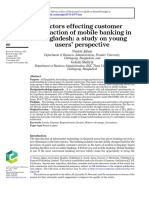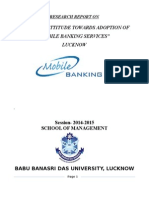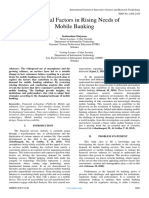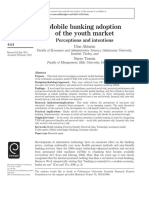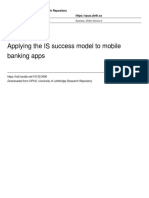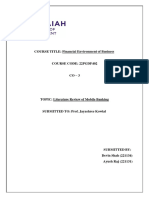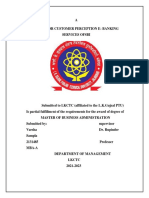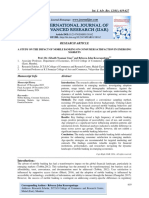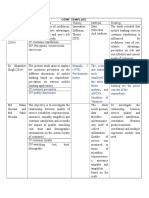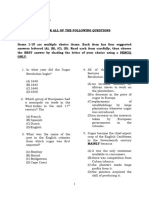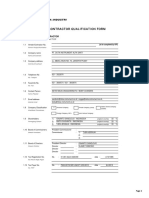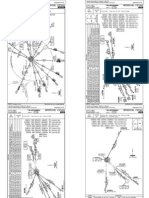NIC Asia Report
Uploaded by
apar.singha7NIC Asia Report
Uploaded by
apar.singha7Volume 5, Issue 4 (December 2023) ISSN: 2705-4683; e-ISSN: 2705-4748
A CASE STUDY OF NIC ASIA BANK ON CUSTOMER’S PERCEPTION OF ADAPTATION OF MOBILE
BANKING SERVICES
Hrishav Koirala1, Suman Bhattacharya2
1PG Scholar, Lord Buddha Education Foundation, Kathmandu, Nepal
2 Professor, Lord Buddha Education Foundation, Kathmandu, Nepal
Abstract
This research report examines customer perceptions and preferences towards mobile banking
services offered by NIC Asia Bank in Nepal. Digitalization has led to the adoption of mobile
banking services, with NIC Asia Bank embracing this trend. The study focuses on the factors
influencing mobile banking adoption, such as safety, ease of use, and perceived benefits. The
research questions explore and analyze these relationships, with hypotheses positing positive
correlations. The Technology Acceptance Model is used to understand customer perceptions of
mobile banking services. The research methodology includes positivism, a deductive approach, a
survey strategy, and data collection methods. Results show moderate agreement and positive
perceptions among respondents regarding mobile banking, customer attitude, knowledge, and
awareness. Correlation analysis reveals positive correlations between these variables. The study
concludes that positive attitudes, awareness, and knowledge positively influence customer
perceptions of mobile banking services. Implications for digital technologies and the banking
sector include customer experience improvements and tailored offerings. Recommendations
include prioritizing security, user-friendly designs, promoting benefits, enhancing customer
engagement, ensuring ongoing security measures, and adapting to changes. The findings have
LBEF Research Journal of Science, Technology and Management 62
Volume 5, Issue 4 (December 2023) ISSN: 2705-4683; e-ISSN: 2705-4748
implications for enhancing customer satisfaction, improving services, and guiding technological
advancements in the banking sector.
Key Words: Consumers’ Perception, Mobile Banking, Services
LBEF Research Journal of Science, Technology and Management 63
Volume 5, Issue 4 (December 2023) ISSN: 2705-4683; e-ISSN: 2705-4748
1 Chapter 1: Introduction
1.1. Background of the Study
Banks play a crucial role in the economy by providing safe and secure financial services to
people and businesses. They offer long-term loans and deposits, ensuring smooth economic flow
and maintaining the smooth functioning of businesses. Digitalization is revolutionizing the way
banks process data and information, enabling them to offer innovative services to customers
both locally and globally. Mobile banking, which involves using a mobile device for various
financial activities, is becoming increasingly popular (Arch, 2020).
Banks are implementing security measures, such as private networks, special logins, and extra
verification steps, to ensure the safety of their client's accounts. In Nepal, mobile banking services
are growing at a rate of 35%, with 95% of internet users using mobile devices. NIC Asia Bank
Limited has started using mobile banking, with 1.5 million users as of mid-May. With BFIs, 16.12
million people have savings accounts (Waal, 2009).
1.2. Problem Statement
• A 2019 survey found that mobile banking adoption is influenced by factors like
helpfulness, safety, ease of use, privacy, trust, security, compatibility, and perceived
benefits (Kelly and Palaniappan, 2019).
• Study shows positive perceptions of mobile banking apps are linked to cognitive aspects,
usefulness, and privacy security (Yin and Lin, 2022).
• Report shows customer satisfaction in rural areas influenced by dependability,
adaptability, productivity, and loyalty (Bala et al., 2021).
1.3. Research Question
• Is there a significant relationship between customer attitude and the perception of
customers to adopt mobile banking services?
LBEF Research Journal of Science, Technology and Management 64
Volume 5, Issue 4 (December 2023) ISSN: 2705-4683; e-ISSN: 2705-4748
• Is there a significant relationship between customers’ awareness and the perception of
the customers to adopt mobile banking services?
• Is there a significant relationship between customers’ knowledge and the perception of
the customers to adopt mobile banking services?
1.1 1.4. Research Objectives
• To study whether there is a significant relationship between customer attitude and the
perception of customers to adopt mobile banking services.
• To study whether there is a significant relationship between customers’ awareness and
the perception of the customers to adopt mobile banking services.
• To find out whether there is a significant relationship between customers’ knowledge and
the perception of the customers to adopt mobile banking services.
1.2 1.5. Research Hypothesis
H1: There is a positive relationship between customer attitude and the perception of customers
to adopt mobile banking services.
H2: There is a positive relationship between customers’ awareness and the perception of the
customers to adopt mobile banking services.
H3: There is a positive relationship between customers’ knowledge and the perception of the
customers to adopt mobile banking services.
1.3 1.6. Significance
• Customer-focused approach: Adapt digital banking to meet customer needs, enhancing
satisfaction and usage.
• Enhanced digital offerings: Use findings to improve security, engagement, and overall
mobile banking services.
• Improved decision-making: Study results aid choices in tech investment and staff
training.
LBEF Research Journal of Science, Technology and Management 65
Volume 5, Issue 4 (December 2023) ISSN: 2705-4683; e-ISSN: 2705-4748
• Contribution to the banking sector: Guide for other banks, advancing understanding of
mobile banking in Nepal.
1.4 1.7. Scope
• Consumer sentiment towards NIC Asia Bank's mobile banking initiatives in Nepal.
• Evaluation of usability, security, and accessibility impacting client perception.
• Measuring satisfaction with NIC Asia Bank's mobile banking in Nepal.
• Awareness of challenges in using the bank's mobile services.
• Research customer desires and improve digital products.
1.5 1.8. Limitations
• Sampling bias: Conclusions based on a limited customer sample, not representing all
opinions.
• Data reliability: Results depend on data quality and self-reported data could be
unreliable.
• Limited applicability: Findings specific to NIC Asia Bank in Nepal, might not apply to other
banks.
• Time-specific: The study's conclusions are relevant only to a specific period.
• Assumptions: Relies on customer honesty and participation.
LBEF Research Journal of Science, Technology and Management 66
Volume 5, Issue 4 (December 2023) ISSN: 2705-4683; e-ISSN: 2705-4748
2 Chapter 2: Literature Review
2.1 2.1. Research Theory
The Technology Acceptance Model (TAM) is a research framework that helps understand
how customers perceive and welcome the use of mobile banking services, particularly at NIC Asia
Bank. It focuses on the belief in the usefulness and ease of use of new technology, which affects
its adoption. Measurements of perceived usefulness and ease of use can help understand why
customers choose or avoid using mobile banking services. TAM can also identify factors like
gender, educational background, age, and familiarity with mobile banking services that impact
customer perceptions of utility and user-friendliness (Theoryhub, 2023).
To understand customer sentiments, surveys, interviews, or focus groups can be
conducted to understand what drives them to adopt or avoid mobile banking services. This data
can help the bank understand how to improve the mobile banking experience and attract more
customers. Overall, using TAM as a research model provides a systematic way to study customer
perceptions and usage of mobile banking services, providing actionable insights for the bank to
enhance its mobile banking experience.
2.2 2.2. Base Papers Literature Review
2.3 2.2.1. Customer perspectives on the acceptance of FinTech within the Islamic banking
industry in Malaysia and Saudi Arabia.
Customers’ perceptions of FinTech adaptability in the Islamic banking sector: comparative study
Title on Malaysia and Saudi Arabia
Author Name/Year Ruhaini M., Md. M. Alam, O. R. Olaopa, and Ibrahim A. Oladapo/2020–2021.
1. The document offers an outline of the Islamic banking industry, the evolution of financial
Features technology (FinTech), and the foundational framework for the study.
2. The review explores the elements influencing consumer adoption of fintech.
3. The research investigates how customers perceive the adoption of FinTech in the Islamic banking
sectors of Malaysia and Saudi Arabia. The report presents the study's findings.
LBEF Research Journal of Science, Technology and Management 67
Volume 5, Issue 4 (December 2023) ISSN: 2705-4683; e-ISSN: 2705-4748
1. The research furnishes insights into how consumers within Malaysia and Saudi Arabia perceive
the utilization of fintech within the Islamic banking domain. This data can facilitate enhanced
customer comprehension for Islamic banking establishments, leading to advancements in their
Benefits provided products and services.
2. In order to help Islamic banking institutions grow their clientele and tap into new markets, the
paper analyses opportunities for FinTech acceptance and utilization in the sector.
3. The paper provides evidence-based information that Islamic financial institutions can use to
inform their decisions about the adoption and use of FinTech.
1. The research is of a descriptive nature and does not establish a causal connection
Limitations between the variables that are being examined.
2. The study only uses quantitative methods for gathering and analyzing data.
3. The sample size of the study is fairly small, making it more difficult to apply the findings
to other Islamic banking systems and countries.
1. The paper places special emphasis on the challenges Islamic banking institutions face
Advantages while integrating and utilizing FinTech.
2. The paper explains the possibility that FinTech will be adopted and used in the Islamic
banking sector.
3. The survey offers crucial data concerning customers' views on the adaptability of FinTech
within the banking sector of Islam, aiding its banking enterprises in gaining a deeper
understanding of their consumers and improving their offerings.
Techniques for The employed research approach is the quantitative research methodology.
Research
Model The utilized model for conducting this research is the descriptive one.
Table 1: Literature Review on Customer perspectives on the acceptance of FinTech within the
Islamic banking industry in Malaysia and Saudi Arabia
LBEF Research Journal of Science, Technology and Management 68
Volume 5, Issue 4 (December 2023) ISSN: 2705-4683; e-ISSN: 2705-4748
2.4 2.2.2. Influencing factors behind India's mobile banking adoption
Title Consumer perspectives about mobile banking adoption in India – a cluster analysis
Author Name/Year D. Chawla and H. Joshi / 2016
Features 1. Indian consumer behavior and attitudes toward the use of mobile banking.
2. Factors influencing India's adoption of mobile banking
3. Different client categories according to their attitudes and actions towards mobile
banking.
4. Strategies for enhancing the adoption rates of mobile banking services in India.
1. Furnishes information regarding the demographic factors, technological challenges, and
confidence in financial establishments that influence the uptake of mobile banking among
Benefits Indians.
2. Categorizes customer demographic groups according to their perceptions and usage of
mobile banking, empowering suppliers to tailor their services effectively.
3. Gives advice to mobile banking service providers of India for increasing the rates of
adoption.
1. The study's limited sample size might lead to results that are not fully representative of
Limitations all Indian mobile banking users.
2. The employment of a cross-sectional approach in the study offers only a concise snapshot
of consumer behaviors and attitudes regarding mobile banking utilization.
3. The survey only included feedback from users of mobile banking services and eliminated
responses from non-users.
1. The study makes it simpler to pinpoint primary determinants that impact the utilization
of mobile banking services in India., such as demography, technical difficulties, and trust in
Advantages financial institutions.
2. The study divides the groups of people who use mobile banking into several subgroups
based on their attitudes and behaviors.
LBEF Research Journal of Science, Technology and Management 69
Volume 5, Issue 4 (December 2023) ISSN: 2705-4683; e-ISSN: 2705-4748
3. The research findings can be used by decision-makers to develop laws and regulations
that support the boost of mobile banking within India.
Techniques for The employed research approach is the quantitative research methodology.
Research
Model The utilized model for conducting this research is the descriptive one.
Table 2: Literature Review on Influencing factors behind India's mobile banking adoption
LBEF Research Journal of Science, Technology and Management 70
Volume 5, Issue 4 (December 2023) ISSN: 2705-4683; e-ISSN: 2705-4748
3 Chapter 3: Research Methodology
3.1 3.1. Introduction
A research method outlines a logical, organized approach for a study, involving data
collection, gathering, and analysis of information (Lovino, 2020).
3.2 3.2. Research Philosophy
The research philosophy of a study is its fundamental ideas, assumptions, and vision (Lovino,
2020).
• Positivism: Uses scientific methods, like stats and hypotheses (Lovino, 2020).
• Interpretivism: Focuses on subjective human experience (Lovino, 2020).
This research will be using Positivism.
3.3 3.3. Research Approach
A set of rules and methods known as the research approach defines how an entire study
will be conducted (Kirti, 2022).
• Deductive: Start with theory, test with data (Spens, 2006).
• Inductive: Begin with observations, then form theory (Spens, 2006).
This research is conducted using a Deductive approach.
3.4 3.4. Research Strategy
Research methodology involves selecting the best approach based on study aims and
questions. This study will use a survey with a questionnaire distributed to target populations,
analyzing data from respondents (Magusiak, 2023).
3.5 3.5. Methodology
Research methodology involves procedures for locating, choosing, compiling, and
evaluating data on a topic. Qualitative research involves focus groups, interviews, and
observations, while quantitative methods use surveys, databases, tests, and questionnaires. A
LBEF Research Journal of Science, Technology and Management 71
Volume 5, Issue 4 (December 2023) ISSN: 2705-4683; e-ISSN: 2705-4748
mixed-methods approach combines qualitative and quantitative concepts for a more realistic
view (Potgieter, 2022).
The technique for this study will be a mixed-methods approach.
3.6 3.6. Time Horizon
Time horizon refers to data gathering instances, with longitudinal and cross-sectional
approaches. Longitudinal time horizons examine developments over time, while cross-sectional
time horizons gather information at a single point (Jansen, 2021).
3.7 3.7. Data
Data is the primary source of information obtained, executed, and reviewed in research
tasks. Primary data is untouched by prior analysis, making it inherently "pure." Secondary data,
acquired from the original point of collection, indicates material accumulated by researchers
(Lovino, 2020).
This research will use both primary and secondary data.
3.8 3.8. Instruments
Instrumentation is a tool used for collecting, measuring, and analyzing data in research,
affecting qualitative, quantitative, or mixed techniques (Murshed, 2016).
The research instrumentation will be a questionnaire.
3.9 3.9. Sources of Data
Primary and secondary sources are used to gather data, including observations,
experiments, surveys, and interviews, while secondary sources are pre-existing findings.
3.10 3.10. Sampling
This research will use convenience sampling to collect information from 350-400 people.
LBEF Research Journal of Science, Technology and Management 72
Volume 5, Issue 4 (December 2023) ISSN: 2705-4683; e-ISSN: 2705-4748
3.11 3.11. Research Model
Customer
Knowledge
Customer Customer
Attitude Awareness
Mobile
Banking
Figure 1: Research Model
Independent Variable
Dependent Variable
3.12 3.12. Data Processing
Data processing involves editing and coding surveys to correct technical mistakes, missing
information, and gaps, and converting data into numerical form before submitting to a
spreadsheet.
3.13 3.13. Data Analysis
Data analysis is a strategy for organizing, analyzing, and drawing conclusions from vast
amounts of information. It helps break down information into manageable portions, ensuring
reliability and validity in measurements and tests.
LBEF Research Journal of Science, Technology and Management 73
Volume 5, Issue 4 (December 2023) ISSN: 2705-4683; e-ISSN: 2705-4748
3.14 3.14. Ethical consideration
Researchers must adhere to ethical considerations for proper money management,
research misconduct prevention, and public trust.
4 Chapter 4: Findings and Analysis of Data
1.4.Introduction
This chapter discusses data presentation, analysis, and conclusions from a survey
questionnaire gathered from 336 clients. The study aims to improve NIC Asia Bank's mobile
banking services and provide actionable insights for customer satisfaction and long-term success
in digital banking.
1.5. Respondents Feedback
Questionnaire Number of Questionnaires
Distributed 370
Collected 336
Table 3: Respondents Feedback
A survey approach was used to gather 336 closed-ended samples, with 370 respondents
given questionnaires. However, some were not returned and errors were discovered in replies,
resulting in a total of 336 test data generation.
1.6. Reliability Test
Reliability Statistics
Cronbach's Alpha N of Items
.978 27
Table 4:Reliability Test
LBEF Research Journal of Science, Technology and Management 74
Volume 5, Issue 4 (December 2023) ISSN: 2705-4683; e-ISSN: 2705-4748
A reliability test for numerous questions in a survey is known as Cronbach's Alpha.
Cronbach's alpha is .978, which is very good. This indicates that the survey's 27 questions are
closely related and consistently assess the same thing.
1.7. Descriptive Statistics of Variables
Variables Mean Std. Deviation N
Mobile Banking 3.3470 .98462 336
Customer Attitude 3.6414 .90901 336
Customer Knowledge 3.6131 .88404 336
Customer Awareness 3.5992 .92805 336
Table 5: Descriptive Statistics of Variables
The study's data shows moderate agreement or positive perceptions for Mobile Banking,
Customer Attitude, Customer Knowledge, and Customer Awareness among participants. The
mean scores are 3.3470, 3.6414, 3.6131, and 3.5992, respectively. The standard deviations show
moderate variability, with responses clustering close to the mean scores.
1.8. Correlation Analysis
Mobile Customer Customer Customer
Banking Attitude Knowledge Awareness
Pearson Mobile Banking 1.000 .708 .737 .737
Correlation Customer .708 1.000 .885 .865
Attitude
Customer .737 .885 1.000 .878
Knowledge
Customer .737 .865 .878 1.000
Awareness
Sig. (1-tailed) Mobile Banking . .000 .000 .000
LBEF Research Journal of Science, Technology and Management 75
Volume 5, Issue 4 (December 2023) ISSN: 2705-4683; e-ISSN: 2705-4748
Customer .000 . .000 .000
Attitude
Customer .000 .000 . .000
Knowledge
Customer .000 .000 .000 .
Awareness
Table 6: Correlation Analysis
The correlation matrix displays the correlation coefficients between Mobile Banking,
Customer Attitude, Customer Knowledge, and Customer Awareness. Positive correlations are
observed between Mobile Banking and Customer Attitude (0.708), Mobile Banking and Customer
Knowledge (0.736), and Mobile Banking and Customer Awareness (0.778). These positive
correlations indicate a tendency for both variables to rise as one increases. Overall, the data
indicates moderate to strong positive relationships between these variables.
1.9. Normality Testing
Figure 3: Regression Standardized Residual Figure 2: Linear Line Residual Plot
LBEF Research Journal of Science, Technology and Management 76
Volume 5, Issue 4 (December 2023) ISSN: 2705-4683; e-ISSN: 2705-4748
It is concluded from the above graphic that the data are often symmetrically distributed
around the mean. It indicates that the histogram's left and right halves are approximately
mirrored. The linear line residual plot also clarified the same idea. It is also clear from the
mentioned Normal P-P Plot of Regression Standardized Residual that the points on the PP plot
approximately follow a straight line.
1.10. Multiple Regression Analysis
It is a statistical method that enables the investigation of the connection between a single
dependent variable and several independent variables.
4.1 4.7.1 Model Summary Table
Model R R Square Adjusted R Square Std. Error of the Estimate
1 .886a .785 .764 .55213
a. Predictors: (Constant), Customer Awareness, Customer Knowledge, Customer Attitude
b. Dependent Variable: Mobile Banking
Table 7: Model Summary Table
The study's adjusted R-squared value of.764 shows that 76.4% of the variance in mobile
banking is accounted for by independent variables (Customer Awareness, Customer Knowledge,
and Customer Attitude) in the regression model, indicating a strong positive correlation between
the variables.
4.2 4.7.2. ANOVA
Model Sum of Squares df Mean Square F Sig.
1 Regression 188.601 3 62.867 153.270 .000b
Residual 136.176 332 .410
Total 324.777 335
LBEF Research Journal of Science, Technology and Management 77
Volume 5, Issue 4 (December 2023) ISSN: 2705-4683; e-ISSN: 2705-4748
a. Dependent Variable: Mobile Banking
b. Predictors: (Constant), Customer Awareness, Customer Attitude, Customer Knowledge
Table 8: ANOVA
The F value of 153.270 indicates greater variation between groups, while a P value of.000b
indicates a significant interaction between the dependent variable (Mobile Banking) and
independent variables (Customer Awareness, Customer Attitude, Customer Knowledge). This
indicates that the independent variable is a significant predictor of the dependent variable.
4.3 4.7.3. Coefficient Table
Coefficientsa
Unstandardized Standardized
Coefficients Coefficients
Model B Std. Error Beta t Sig.
1 (Constant) .238 .150 1.580 .115
Customer Attitude .128 .090 .118 1.423 .156
Customer Knowledge .364 .097 .327 3.767 .000
Customer Awareness .369 .086 .347 4.296 .000
a. Dependent Variable: Mobile Banking
Table 9: Coefficient Table
a. Perception of customers to use Mobile banking is projected to increase by 0.128 units
when the relationship with customer attitude increases by one unit when all other
independent variables remain constant, and vice versa (positive impact).
b. Perception of customers to use Mobile banking is projected to increase by 0.364 units
when the relationship with customer knowledge increases by one unit when all other
independent variables remain constant, and vice versa (positive impact).
LBEF Research Journal of Science, Technology and Management 78
Volume 5, Issue 4 (December 2023) ISSN: 2705-4683; e-ISSN: 2705-4748
c. Perception of customers to use Mobile banking is projected to increase by 0.369 units
when the relationship with customer awareness increases by one unit when all other
independent variables remain constant, and vice versa (positive impact).
All three independent variables positively impacted the dependent variables.
4.4 4.7.4. Results of Hypothesis
Developed Hypothesis P- Impact Status of
Value Developed
Hypothesis
H1: There is a positive relationship between customer 0.156 Positive Supported
attitude and the perception of customers to adopt mobile
banking services.
H2: There is a positive relationship between customers’ 0.000 Positive Supported
awareness and the perception of the customers to adopt
mobile banking services.
H3: There is a positive relationship between customers’ 0.000 Positive Supported
knowledge and the perception of the customers to adopt
mobile banking services.
Table 10: Results of Hypothesis
LBEF Research Journal of Science, Technology and Management 79
Volume 5, Issue 4 (December 2023) ISSN: 2705-4683; e-ISSN: 2705-4748
5 Chapter 5: Conclusion and Recommendation
5.1 5.1. Discussion of Findings
Question 1: Is there a significant relationship between customer attitude and the perception of
customers to adopt mobile banking services?
The study explored the relationship between people's attitudes and their perceptions of
mobile banking. A positive attitude towards mobile banking was linked to a positive attitude
towards its application. A strong coefficient value of 0.708 indicated a strong connection between
attitude and perceptions. Multiple regression analysis supported the proposition's validity,
revealing that changes in attitudes can explain significant fluctuations in opinions about mobile
banking. Even small changes in attitudes were associated with more favorable perceptions of
using mobile banking, highlighting the complex relationship between attitudes and perceptions.
Question 2: Is there a significant relationship between customers’ awareness and the
perception of the customers to adopt mobile banking services?
The research highlights the connection between customer perceptions and awareness of
mobile banking adoption. A strong match and R-value of 0.886 confirm the strong association
between customers' opinions and their awareness of the topic. Variations in customer awareness
levels account for 76.4% of the variability in opinions on mobile banking use. The coefficient table
provides comprehensive details about these relationships, with a positive-signed unstandardized
coefficient value of 0.369 given to client awareness. These results support the hypothesis that
aware consumers are more likely to embrace mobile banking, opening the door for future
improvements in banking procedures and consumer behavior.
Question 3: Is there a significant relationship between customers’ knowledge and the
perception of the customers to adopt mobile banking services?
The study highlights the significant relationship between consumer knowledge and their
perceptions of mobile banking adoption. A strong correlation value of 0.885 highlights the
importance of consumer knowledge in influencing financial technology choices. Greater
LBEF Research Journal of Science, Technology and Management 80
Volume 5, Issue 4 (December 2023) ISSN: 2705-4683; e-ISSN: 2705-4748
consumer knowledge leads to a more favorable attitude toward mobile banking adoption. The
model summary table and R-value of 0.886 support this claim, with a corrected R-square value
of 0.764. The customer knowledge variable has a positively signed unstandardized coefficient
value of 0.364, highlighting its critical significance. This knowledge-based link highlights the role
of well-informed consumers in market development and illuminates the trend of mobile banking
technology adoption.
5.2 5.2. Implication of Study
The study on customer perceptions and preferences in mobile banking interactions with
NIC Asia Bank has significant implications for digital technologies and the banking sector. It
highlights the importance of fostering pleasant customer experiences and improving mobile
banking offerings. Financial organizations can improve their mobile banking approach by
prioritizing user-friendly interfaces, raising awareness, and providing thorough customer
education. Demographic traits also play a crucial role in influencing how people perceive mobile
banking.
5.3 5.3. Conclusion
NIC Asia Bank, in particular, can benefit from a deeper understanding of client
preferences and the decision-making process for mobile banking according to this study. It
examines the complex connections that exist between the ideas and perceptions of customers
and places an emphasis on the significance of their interactions with digital banking platforms.
The findings indicate that financial institutions should work to improve customer happiness with
mobile banking, as well as raise knowledge of its benefits and encourage more widespread use
of the technology. This can lead to improved services, individualized products, and equitable
collaboration between users of mobile banking technology and the technology itself, which
ensures compatibility with the digital age.
LBEF Research Journal of Science, Technology and Management 81
Volume 5, Issue 4 (December 2023) ISSN: 2705-4683; e-ISSN: 2705-4748
5.4 5.4. Recommendations
• Security and Privacy: Prioritize strong security methods: advanced protection, unique
codes, and customer verification. Inform customers of boosted confidence.
• User-Friendly Design: Focus on intuitive app design: clear layouts, easy navigation.
Encourage usage and enjoyment.
• Highlight Benefits: Create informative content, ads, and guides for mobile banking
advantages. Educate on benefits, security, and time-saving. Address common concerns.
• Customer Engagement: Strengthen ties with rewards, special programs, and incentives
for regular mobile banking. Foster long-term satisfaction.
• Ongoing Security: Invest in robust measures: security plans, codes, protect data, and
transactions. Communicate for trust.
• Adapt to Changes: Stay updated with digital advancements. Listen to feedback, observe
usage, make regular updates. Meet evolving customer needs.
LBEF Research Journal of Science, Technology and Management 82
Volume 5, Issue 4 (December 2023) ISSN: 2705-4683; e-ISSN: 2705-4748
References
Alsmadi, A.A. et al. (2022) ‘Twenty Years of Mobile Banking Services Development and
Sustainability: A Bibliometric Analysis Overview (2000–2020)’, Sustainability, 14(17), p.
10630. Available at: https://doi.org/10.3390/su141710630.
Bala, T. et al. (2021) ‘Service Quality and Customer Satisfaction of Mobile Banking during
COVID-19 Lockdown; Evidence from Rural Area of Bangladesh’, Open Journal of Business
and Management, 9(5), pp. 2329–2357. Available at:
https://doi.org/10.4236/ojbm.2021.95126.
Bruscia, K.E., 2005. Data analysis in qualitative research. Music therapy research, 2, pp.179-186.
Arch, L., 2020. Effective bank regulation: seven guiding principles. Journal of Financial
Regulation and Compliance.
Tam, C. and Oliveira, T., 2017. Literature review of mobile banking and individual
performance. International Journal of Bank Marketing, 35(7), pp.1044-1067.
Hassan, M. (2022) Research Approach - Types Methods, Research Method. Available at:
https://researchmethod.net/research-approach/ (Accessed: 23 February 2023).
Heywood, F., 2002. Adaptations: key evidence for managers. Journal of Integrated Care, 10(5),
pp.13-17.
Indeed (2022) What Is Research Methodology? (Why It’s Important and Types), Indeed Career
Guide. Available at: https://www.indeed.com/career-advice/career-
development/research-methodology (Accessed: 22 February 2023).
IVY Panda (2021) Research Philosophy: Importance and Types - 834 Words | Research Paper
Example, Free Essays. Available at: https://ivypanda.com/essays/research-philosophy-
importance-and-types/ (Accessed: 23 February 2023).
Jansen, D. (2021) ‘Saunders’ Research Onion Explained (+ Examples)’, Grad Coach, 26 January.
Available at: https://gradcoach.com/saunders-research-onion/ (Accessed: 25 February
2023).
LBEF Research Journal of Science, Technology and Management 83
Volume 5, Issue 4 (December 2023) ISSN: 2705-4683; e-ISSN: 2705-4748
Kelly, A.E. (2019) ‘Survey on Customer Satisfaction, Adoption, Perception, Behaviour, and
Security on Mobile Banking’, 9(259).
Kirti (2022) ‘What is Research Approaches ? | Meaning and Types of Research Approaches’,
Top4u, 30 January. Available at: https://www.toppers4u.com/2022/01/what-is-
research-approaches-meaning-and.html (Accessed: 23 February 2023).
Iovino, F. and Tsitsianis, N., 2020. The methodology of the research. In Changes in European
energy markets (pp. 79-95). Emerald Publishing Limited.
Magusiak, D. (2023) Research strategy, CEOpedia | Management online. Available at:
https://ceopedia.org/index.php/Research_strategy (Accessed: 23 February 2023).
Mazumdar, M. (2022) ‘Ethical considerations in research every author should know | Ethical
Considerations in Conducting Research – Researcher.Life’, 18 March. Available at:
https://researcher.life/blog/article/ethical-guidelines-for-researchers/ (Accessed: 25
February 2023).
McCombes, S. (2019) Sampling Methods | Types, Techniques & Examples, Scribbr. Available at:
https://www.scribbr.com/methodology/sampling-methods/ (Accessed: 25 February
2023).
Murshed, F. and Zhang, Y., 2016. Thinking orientation and preference for research
methodology. Journal of Consumer Marketing.
Nagar, N. and Ghai, E., 2019. A Study of Bank Customer’s Reliability towards Electronic
Banking (E-Banking) Channel’s. Int. J. Manag. Stud, 6, p.34.
Pamplona, F. (2022) ‘What is Methodology in Research and How Can We Write it?’, Mind
the Graph Blog, 3 August. Available at: https://mindthegraph.com/blog/what-is-
methodology-in-research/ (Accessed: 25 February 2023).
Potgieter, S. (2022) LibGuides: Research Support: Research Methodology. Available at:
https://libguides.wits.ac.za/c.php?g=693518&p=4914913 (Accessed: 24 February 2023).
LBEF Research Journal of Science, Technology and Management 84
Volume 5, Issue 4 (December 2023) ISSN: 2705-4683; e-ISSN: 2705-4748
Pérez, A. and Rodríguez Del Bosque, I., 2015. Customer responses to the CSR of banking
companies. Journal of Product & Brand Management, 24(5), pp.481-493.
De Waal, A. and Frijns, M., 2009. Working on high performance in Asia: the case of Nabil
Bank. Measuring Business Excellence.
Spens, K.M. and Kovács, G., 2006. A content analysis of research approaches in logistics
research. International journal of physical distribution & logistics management.
Taherdoost, H., 2016. Sampling methods in research methodology; how to choose a sampling
technique for research. How to choose a sampling technique for research (April 10,
2016).
Theoryhub (2023) TheoryHub - Academic theories reviews for research and T&L. Available at:
https://open.ncl.ac.uk/theories/1/technology-acceptance-model/ (Accessed: 26
February 2023).
University of Reading (2023) Research data defined. Available at:
https://www.reading.ac.uk/research-services/Research data management/About
research data management/Research data defined (Accessed: 25 February 2023).
Wodo, W., Stygar, D. and Blaskiewicz, P., 2021, July. Security Issues of Electronic and Mobile
Banking. In SECRYPT (pp. 631-638).
Yin, L.-X. and Lin, H.-C. (2022) ‘Predictors of customers’ continuance intention of mobile
banking from the perspective of the interactivity theory’, Economic Research-
Ekonomska Istraživanja, 35(1), pp. 6820–6849. Available at:
https://doi.org/10.1080/1331677X.2022.2053782.
Yu, J. and Nuangjamnong, C. (2022) ‘The Impact of Mobile Banking Service on Customer
Satisfaction: A Case Study of Commercial Banks in China » UIJRT’. Available at:
https://uijrt.com/paper/the-impact-of-mobile-banking-service-on-customer-satisfaction
(Accessed: 22 February 2023).
LBEF Research Journal of Science, Technology and Management 85
You might also like
- Analysis of Perception of The Customers Towards Digitization of Banking SectorNo ratings yetAnalysis of Perception of The Customers Towards Digitization of Banking Sector11 pages
- An Analysis of Customer Perception On Mobile Banking in BotswanaNo ratings yetAn Analysis of Customer Perception On Mobile Banking in Botswana5 pages
- Banking "On-The-Go" Examining Consumers' Adoption of Mobile Banking Services-2016No ratings yetBanking "On-The-Go" Examining Consumers' Adoption of Mobile Banking Services-201617 pages
- Customer Satisfaction of Service Quality AssessingNo ratings yetCustomer Satisfaction of Service Quality Assessing15 pages
- Understanding The Intention To Use Mobile Banking by Existing Online Banking Customers: An Empirical StudyNo ratings yetUnderstanding The Intention To Use Mobile Banking by Existing Online Banking Customers: An Empirical Study11 pages
- Influential Factors in Rising Needs of Mobile BankingNo ratings yetInfluential Factors in Rising Needs of Mobile Banking5 pages
- What Improves Customer Satisfaction in Mobile Banking Apps - An APNo ratings yetWhat Improves Customer Satisfaction in Mobile Banking Apps - An AP11 pages
- BRM 2ND Sem Individual Assignment-AlishaNo ratings yetBRM 2ND Sem Individual Assignment-Alisha8 pages
- A Study On Customer Satisfaction On Sbi Yono With Reference To Stonehouse Pet, Nellore.No ratings yetA Study On Customer Satisfaction On Sbi Yono With Reference To Stonehouse Pet, Nellore.27 pages
- Awareness Adoptionand Challengesof Mobile Banking AppNo ratings yetAwareness Adoptionand Challengesof Mobile Banking App7 pages
- Mobile Banking Adoption of The Youth Market: Perceptions and Intentions100% (1)Mobile Banking Adoption of The Youth Market: Perceptions and Intentions16 pages
- Intension To Use Mobile Banking - An Integration of Theory of Planned Behaviour (TPB) and Technology Acceptance Model (TAM)No ratings yetIntension To Use Mobile Banking - An Integration of Theory of Planned Behaviour (TPB) and Technology Acceptance Model (TAM)16 pages
- Applying The Is Success Model To Mobile Banking AppsNo ratings yetApplying The Is Success Model To Mobile Banking Apps169 pages
- A Study On The Consumer Perception Towards Mobile Banking Services of State Bank of India"-With Special Reference To Kollam District "No ratings yetA Study On The Consumer Perception Towards Mobile Banking Services of State Bank of India"-With Special Reference To Kollam District "8 pages
- Factors Influencing Mobile Banking Adoption in BangladeshNo ratings yetFactors Influencing Mobile Banking Adoption in Bangladesh36 pages
- HowDoesPerceived Risk and Trust Affect Mobile Banking Adoption Empirical Evidence From IndiaNo ratings yetHowDoesPerceived Risk and Trust Affect Mobile Banking Adoption Empirical Evidence From India21 pages
- Electronic Commerce Research and Applications: Cho-Hsun LuNo ratings yetElectronic Commerce Research and Applications: Cho-Hsun Lu16 pages
- Effect of Mobile Banking Services in Customer Satisfaction100% (1)Effect of Mobile Banking Services in Customer Satisfaction38 pages
- Impact of Mobile Banking On Customer Satisfaction With Reference To Retail BankingNo ratings yetImpact of Mobile Banking On Customer Satisfaction With Reference To Retail Banking37 pages
- The Effectiveness of Mobile Banking Usage On PeopleNo ratings yetThe Effectiveness of Mobile Banking Usage On People4 pages
- A Study On Digital Transformation in Southeast Bank PLC. (Uttara Branch) : Impacts On Customer Experience.No ratings yetA Study On Digital Transformation in Southeast Bank PLC. (Uttara Branch) : Impacts On Customer Experience.59 pages
- Factors Influencing The Use of Mobile Banking in India: Chanchal MalhotraNo ratings yetFactors Influencing The Use of Mobile Banking in India: Chanchal Malhotra128 pages
- Author Objective/ IV/ DV Theory Method Finding: Otmf TemplateNo ratings yetAuthor Objective/ IV/ DV Theory Method Finding: Otmf Template5 pages
- The Appraisal of Mobile Banking Services Adoption in The Kingdom of BahrainNo ratings yetThe Appraisal of Mobile Banking Services Adoption in The Kingdom of Bahrain6 pages
- Article 8 Mobile Banking Adoption As Challenges (2) - 2 PDFNo ratings yetArticle 8 Mobile Banking Adoption As Challenges (2) - 2 PDF6 pages
- CSPHCL JE Electrical 5 Jan 2022 EnglishNo ratings yetCSPHCL JE Electrical 5 Jan 2022 English33 pages
- Ranjan Kumar Jaiswal Kotak Mahindra BankNo ratings yetRanjan Kumar Jaiswal Kotak Mahindra Bank6 pages
- Social Media Presentation - Yelp - Kittia DedtaryoonNo ratings yetSocial Media Presentation - Yelp - Kittia Dedtaryoon11 pages
- Daud Anderson Macdonald V Norabi' Ah BT Muda, (2011) 1No ratings yetDaud Anderson Macdonald V Norabi' Ah BT Muda, (2011) 17 pages
- Differences Between Face Up Blackjack and Regular BlackjackNo ratings yetDifferences Between Face Up Blackjack and Regular Blackjack2 pages
- 2005 FBLA Introduction To Business CommunicationNo ratings yet2005 FBLA Introduction To Business Communication7 pages
- NCISM Rasa Shastra Evam Bhaishajya Kalpana SyllabusNo ratings yetNCISM Rasa Shastra Evam Bhaishajya Kalpana Syllabus17 pages
- IS208 PROFESSIONAL ISSUES IN INFORMATION SYSTEMS Revised67% (3)IS208 PROFESSIONAL ISSUES IN INFORMATION SYSTEMS Revised2 pages













